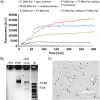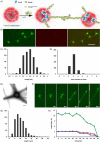Reconstitution and Coupling of DNA Replication and Segregation in a Biomimetic System
- PMID: 31344304
- PMCID: PMC6899551
- DOI: 10.1002/cbic.201900299
Reconstitution and Coupling of DNA Replication and Segregation in a Biomimetic System
Abstract
A biomimetic system capable of replication and segregation of genetic material constitutes an essential component for the future design of a minimal synthetic cell. Here we have used the simple T7 bacteriophage system and the plasmid-derived ParMRC system to establish in vitro DNA replication and DNA segregation, respectively. These processes were incorporated into biomimetic compartments providing an enclosed reaction space. The functional lifetime of the encapsulated segregation system could be prolonged by equipping it with ATP-regenerating and oxygen-scavenging systems. Finally, we showed that DNA replication and segregation processes could be coupled in vitro by using condensed DNA nanoparticles resulting from DNA replication. ParM spindles extended over tens of micrometers and could thus be used for segregation in compartments that are significantly longer than bacterial cell size. Overall, this work demonstrates the successful bottom-up assembly and coupling of molecular machines that mediate replication and segregation, thus providing an important step towards the development of a fully functional minimal cell.
Keywords: DNA nanoparticles; DNA replication; DNA segregation; ParM; T7; minimal cell.
© 2019 Wiley-VCH Verlag GmbH & Co. KGaA, Weinheim.
Conflict of interest statement
Figures






Similar articles
-
Investigation of artificial cells containing the Par system for bacterial plasmid segregation and inheritance mimicry.Nat Commun. 2024 Jun 10;15(1):4956. doi: 10.1038/s41467-024-49412-9. Nat Commun. 2024. PMID: 38858376 Free PMC article.
-
DNA Segregation in Natural and Synthetic Minimal Systems.Adv Biosyst. 2019 Jun;3(6):e1800316. doi: 10.1002/adbi.201800316. Epub 2019 Feb 25. Adv Biosyst. 2019. PMID: 32648710 Review.
-
Structures of actin-like ParM filaments show architecture of plasmid-segregating spindles.Nature. 2015 Jul 2;523(7558):106-10. doi: 10.1038/nature14356. Epub 2015 Apr 27. Nature. 2015. PMID: 25915019 Free PMC article.
-
Functional Modules of Minimal Cell Division for Synthetic Biology.Adv Biosyst. 2019 Jun;3(6):e1800315. doi: 10.1002/adbi.201800315. Epub 2019 Apr 2. Adv Biosyst. 2019. PMID: 32648714 Review.
-
Plasmid replication based on the T7 origin of replication requires a T7 RNAP variant and inactivation of ribonuclease H.Nucleic Acids Res. 2021 Aug 20;49(14):8189-8198. doi: 10.1093/nar/gkab596. Nucleic Acids Res. 2021. PMID: 34255845 Free PMC article.
Cited by
-
Towards a synthetic cell cycle.Nat Commun. 2021 Jul 26;12(1):4531. doi: 10.1038/s41467-021-24772-8. Nat Commun. 2021. PMID: 34312383 Free PMC article. Review.
-
Investigation of artificial cells containing the Par system for bacterial plasmid segregation and inheritance mimicry.Nat Commun. 2024 Jun 10;15(1):4956. doi: 10.1038/s41467-024-49412-9. Nat Commun. 2024. PMID: 38858376 Free PMC article.
-
Bottom-Up Construction of Complex Biomolecular Systems With Cell-Free Synthetic Biology.Front Bioeng Biotechnol. 2020 Mar 24;8:213. doi: 10.3389/fbioe.2020.00213. eCollection 2020. Front Bioeng Biotechnol. 2020. PMID: 32266240 Free PMC article. Review.
References
-
- Schwille P., Spatz J., Landfester K., Bodenschatz E., Herminghaus S., Sourjik V., Erb T. J., Bastiaens P., Lipowsky R., Hyman A., Dabrock P., Baret J.-C., Vidakovic-Koch T., Bieling P., Dimova R., Mutschler H., Robinson T., Tang T.-Y. D., Wegner S., Sundmacher K., Angew. Chem. Int. Ed. 2018, 57, 13382; - PubMed
- Angew. Chem. 2018, 130, 13566.
-
- Fischer H., Hinkle D. C., J. Biol. Chem. 1980, 255, 7956. - PubMed
Publication types
MeSH terms
Substances
Grants and funding
LinkOut - more resources
Full Text Sources

